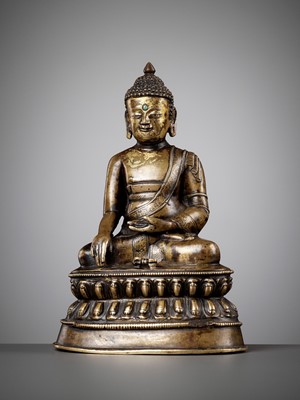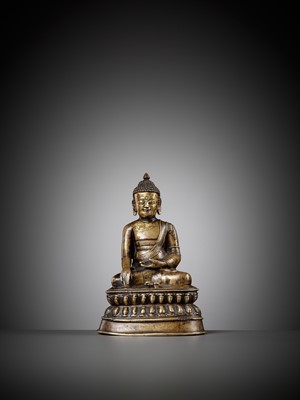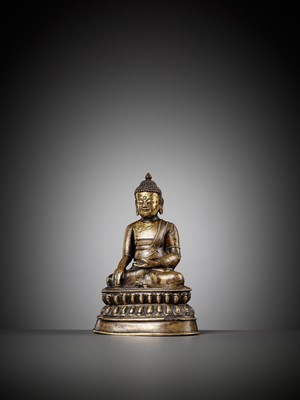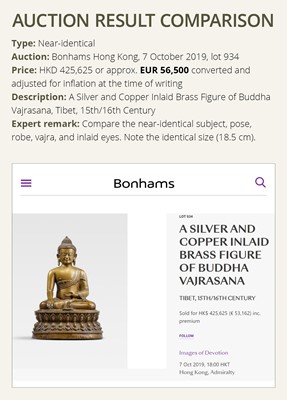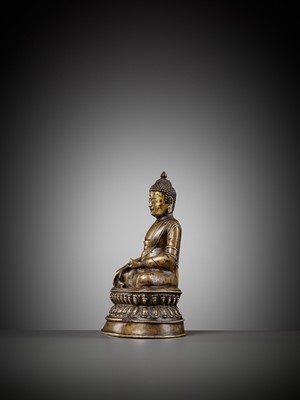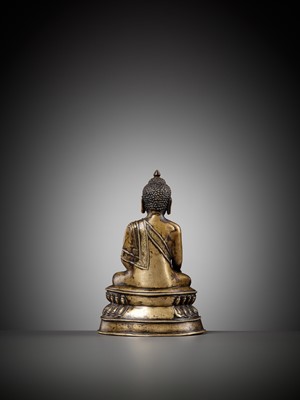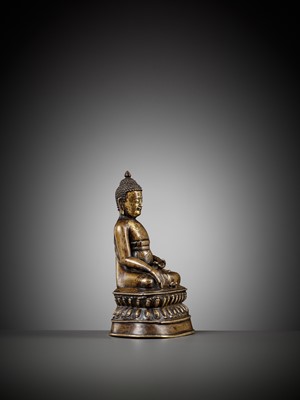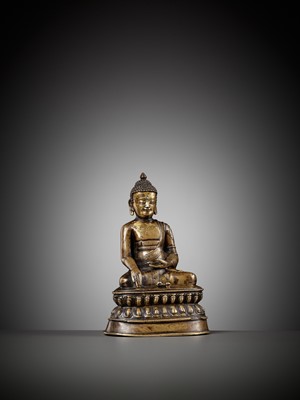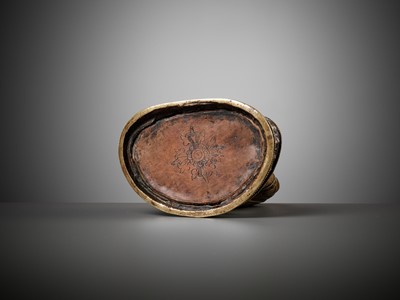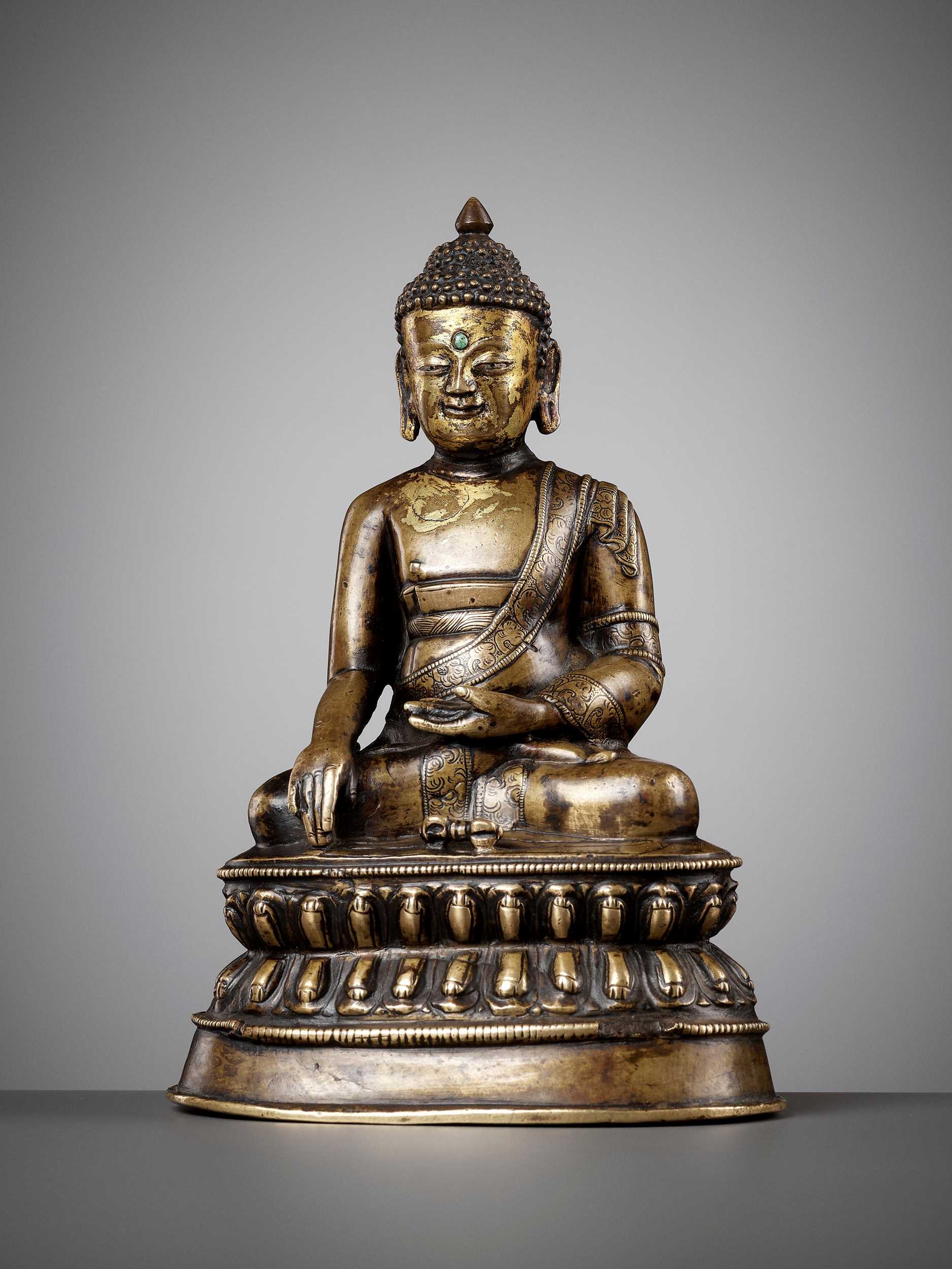29th Sep, 2022 13:00
DAY 1 - TWO-DAY AUCTION - Fine Chinese Art / 中國藝術集珍 / Buddhism & Hinduism
169
A SILVER AND COPPER-INLAID GILT BRASS FIGURE OF BUDDHA VAJRASANA, TIBET, 15TH – 16TH CENTURY
十五至十六世紀西藏錯銀錯紅銅金剛座佛陀銅像
Sold for €5,850
including Buyer's Premium
Seated in vajrasana on a double lotus base with beaded edges, a vajra before him, his right hand lowered in bhumisparsa mudra and the left in avakasha mudra, wearing a loose-fitting monastic robe opening at the chest, the beaded hems neatly incised with foliate scroll. The serene face with heavy-lidded almond-shaped eyes finely inlaid with silver and copper below arched eyebrows centered by a turquoise-inlaid urna. The sealed base incised with a double vajra.
Provenance: From a noted English private collection.
Condition: Good condition with some old wear and traces of use, minor casting flaws, minuscule nicks, light scratches and dents, small losses, extensive wear to gilt. Warm, smooth patina. Sealed.
Weight: 915.7 g
Dimensions: Height 18.5 cm
Expert’s note: This cheerful bronze recalls the moment of Buddha's enlightenment at Bodh Gaya. Gazing at the viewer, he has a particularly amiable countenance. His slender eyes, often seen in art of the Guge Kingdom in Western Tibet, are made more captivating by the use of silver and copper inlay. A bronze Akshobhya from Guge in the Museum Rietberg has similar facial features and rippled pleats above the base (Uhlig, On the Path to Enlightenment, Zurich, 1995, pp. 70-1, no. 29). Yet, similar lotus petals and the exact shape of the mouth are also represented on a standing Avalokiteshvara, suggesting Tsang in Central Tibet as an alternative place of production (see von Schroeder, Buddhist Sculptures in Tibet, Vol. II, Hong Kong, 2001, p. 1192, no. 323A).
Most important of the Buddhist pilgrimage sites is the location of Shakyamuni's enlightenment at the Mahabodhi Temple in Bodh Gaya. Here, it is believed a descendant of the bodhi tree, which Shakyamuni sat under, still stands. His enshrined seat at the Mahabodhi Temple, known as the vajrasana ('vajra seat'), is referenced in this bronze's small vajra placed on top of the lotus pedestal. Unlike many other Buddha images, these 'Buddha Vajrasana' emphasize Shakyamuni's historicity. Recalling a specific spiritual achievement associated with a specific site, its mnemonic vajra no doubt promoted pilgrimage to Bodh Gaya as well.
Auction result comparison:
Type: Near-identical
Auction: Bonhams Hong Kong, 7 October 2019, lot 934
Price: HKD 425,625 or approx. EUR 56,500 converted and adjusted for inflation at the time of writing
Description: A Silver and Copper Inlaid Brass Figure of Buddha Vajrasana, Tibet, 15th/16th Century
Expert remark: Compare the near-identical subject, pose, robe, vajra, and inlaid eyes. Note the identical size (18.5 cm).
十五至十六世紀西藏錯銀錯紅銅金剛座佛陀銅像
佛陀成金剛座坐於雙層蓮座上,面前有一個金剛杵。右手施觸地印,左手禪定印,身著長袍,袒露右肩,面容歡愉,再現佛陀於菩提伽耶悟道之瞬間。雙目含笑,以和藹可親之態凝視觀者,眼睛細長,與紅銅的鑲嵌令其眼目更富神采。雙眉之間綠松石鑲嵌白毫。底部雙金剛杵印封印。
來源:英國知名私人收藏。
品相:品相良好,有一些磨損和使用痕跡,輕微的鑄造缺陷、微小的刻痕、劃痕和凹痕,少量缺損,鎏金廣泛磨損。包漿細膩光滑。底部密封。
重量:915.7 克
尺寸:高18.5 厘米
專家注釋:這尊面容歡愉的佛像再現佛陀於菩提伽耶悟道之瞬間,其細長的眼睛時常可見於藏西古格王朝的造像或壁畫中。瑞特堡博物館現藏一尊古格阿閦佛銅像則帶有相似面部特徵以及蓮花座上橫向堆疊的衣褶(Uhlig,《On the Path to Enlightenment》,蘇黎世,1995年,頁70-1,編號29)。然而,另一尊觀音菩薩立像帶有與其十分類似的蓮花瓣與完全一致的嘴形,或許本拍品可能來自藏中地區(馮·施羅德,《西藏佛教造像》,卷二,香港,2001年,頁1192,編號323A)。
釋迦牟尼在菩提伽耶摩訶菩提寺開悟之處是最重要的佛教朝聖地。據說,釋迦牟尼所坐的菩提樹的後裔仍然屹立於此。他在摩訶菩提寺供奉的座位,被稱為金剛座,這個放置在蓮花座頂部的銅小金剛杵是其象徵。與許多其他佛像不同,“金剛座佛陀” 強調釋迦牟尼的歷史性。
拍賣結果比較:
形制:近乎相同
拍賣:香港邦瀚斯,2019年10月7日,lot 934
價格:HKD 425,625(相當於今日EUR 56,500)
描述:十五或十六世紀西藏錯銀錯紅銅金剛座佛陀銅像
專家評論:比較近乎相同的主題、姿勢、長袍、金剛杵和鑲嵌白毫。請注意相同的尺寸(18.5 厘米)。
Seated in vajrasana on a double lotus base with beaded edges, a vajra before him, his right hand lowered in bhumisparsa mudra and the left in avakasha mudra, wearing a loose-fitting monastic robe opening at the chest, the beaded hems neatly incised with foliate scroll. The serene face with heavy-lidded almond-shaped eyes finely inlaid with silver and copper below arched eyebrows centered by a turquoise-inlaid urna. The sealed base incised with a double vajra.
Provenance: From a noted English private collection.
Condition: Good condition with some old wear and traces of use, minor casting flaws, minuscule nicks, light scratches and dents, small losses, extensive wear to gilt. Warm, smooth patina. Sealed.
Weight: 915.7 g
Dimensions: Height 18.5 cm
Expert’s note: This cheerful bronze recalls the moment of Buddha's enlightenment at Bodh Gaya. Gazing at the viewer, he has a particularly amiable countenance. His slender eyes, often seen in art of the Guge Kingdom in Western Tibet, are made more captivating by the use of silver and copper inlay. A bronze Akshobhya from Guge in the Museum Rietberg has similar facial features and rippled pleats above the base (Uhlig, On the Path to Enlightenment, Zurich, 1995, pp. 70-1, no. 29). Yet, similar lotus petals and the exact shape of the mouth are also represented on a standing Avalokiteshvara, suggesting Tsang in Central Tibet as an alternative place of production (see von Schroeder, Buddhist Sculptures in Tibet, Vol. II, Hong Kong, 2001, p. 1192, no. 323A).
Most important of the Buddhist pilgrimage sites is the location of Shakyamuni's enlightenment at the Mahabodhi Temple in Bodh Gaya. Here, it is believed a descendant of the bodhi tree, which Shakyamuni sat under, still stands. His enshrined seat at the Mahabodhi Temple, known as the vajrasana ('vajra seat'), is referenced in this bronze's small vajra placed on top of the lotus pedestal. Unlike many other Buddha images, these 'Buddha Vajrasana' emphasize Shakyamuni's historicity. Recalling a specific spiritual achievement associated with a specific site, its mnemonic vajra no doubt promoted pilgrimage to Bodh Gaya as well.
Auction result comparison:
Type: Near-identical
Auction: Bonhams Hong Kong, 7 October 2019, lot 934
Price: HKD 425,625 or approx. EUR 56,500 converted and adjusted for inflation at the time of writing
Description: A Silver and Copper Inlaid Brass Figure of Buddha Vajrasana, Tibet, 15th/16th Century
Expert remark: Compare the near-identical subject, pose, robe, vajra, and inlaid eyes. Note the identical size (18.5 cm).
十五至十六世紀西藏錯銀錯紅銅金剛座佛陀銅像
佛陀成金剛座坐於雙層蓮座上,面前有一個金剛杵。右手施觸地印,左手禪定印,身著長袍,袒露右肩,面容歡愉,再現佛陀於菩提伽耶悟道之瞬間。雙目含笑,以和藹可親之態凝視觀者,眼睛細長,與紅銅的鑲嵌令其眼目更富神采。雙眉之間綠松石鑲嵌白毫。底部雙金剛杵印封印。
來源:英國知名私人收藏。
品相:品相良好,有一些磨損和使用痕跡,輕微的鑄造缺陷、微小的刻痕、劃痕和凹痕,少量缺損,鎏金廣泛磨損。包漿細膩光滑。底部密封。
重量:915.7 克
尺寸:高18.5 厘米
專家注釋:這尊面容歡愉的佛像再現佛陀於菩提伽耶悟道之瞬間,其細長的眼睛時常可見於藏西古格王朝的造像或壁畫中。瑞特堡博物館現藏一尊古格阿閦佛銅像則帶有相似面部特徵以及蓮花座上橫向堆疊的衣褶(Uhlig,《On the Path to Enlightenment》,蘇黎世,1995年,頁70-1,編號29)。然而,另一尊觀音菩薩立像帶有與其十分類似的蓮花瓣與完全一致的嘴形,或許本拍品可能來自藏中地區(馮·施羅德,《西藏佛教造像》,卷二,香港,2001年,頁1192,編號323A)。
釋迦牟尼在菩提伽耶摩訶菩提寺開悟之處是最重要的佛教朝聖地。據說,釋迦牟尼所坐的菩提樹的後裔仍然屹立於此。他在摩訶菩提寺供奉的座位,被稱為金剛座,這個放置在蓮花座頂部的銅小金剛杵是其象徵。與許多其他佛像不同,“金剛座佛陀” 強調釋迦牟尼的歷史性。
拍賣結果比較:
形制:近乎相同
拍賣:香港邦瀚斯,2019年10月7日,lot 934
價格:HKD 425,625(相當於今日EUR 56,500)
描述:十五或十六世紀西藏錯銀錯紅銅金剛座佛陀銅像
專家評論:比較近乎相同的主題、姿勢、長袍、金剛杵和鑲嵌白毫。請注意相同的尺寸(18.5 厘米)。
Zacke Live Online Bidding
Our online bidding platform makes it easier than ever to bid in our auctions! When you bid through our website, you can take advantage of our premium buyer's terms without incurring any additional online bidding surcharges.
To bid live online, you'll need to create an online account. Once your account is created and your identity is verified, you can register to bid in an auction up to 12 hours before the auction begins.
Intended Spend and Bid Limits
When you register to bid in an online auction, you will need to share your intended maximum spending budget for the auction. We will then review your intended spend and set a bid limit for you. Once you have pre-registered for a live online auction, you can see your intended spend and bid limit by going to 'Account Settings' and clicking on 'Live Bidding Registrations'.
Your bid limit will be the maximum amount you can bid during the auction. Your bid limit is for the hammer price and is not affected by the buyer’s premium and VAT. For example, if you have a bid limit of €1,000 and place two winning bids for €300 and €200, then you will only be able to bid €500 for the rest of the auction. If you try to place a bid that is higher than €500, you will not be able to do so.
Online Absentee and Telephone Bids
You can now leave absentee and telephone bids on our website!
Absentee Bidding
Once you've created an account and your identity is verified, you can leave your absentee bid directly on the lot page. We will contact you when your bids have been confirmed.
Telephone Bidding
Once you've created an account and your identity is verified, you can leave telephone bids online. We will contact you when your bids have been confirmed.
Classic Absentee and Telephone Bidding Form
You can still submit absentee and telephone bids by email or fax if you prefer. Simply fill out the Absentee Bidding/Telephone bidding form and return it to us by email at office@zacke.at or by fax at +43 (1) 532 04 52 20. You can download the PDF from our Upcoming Auctions page.
How-To Guides
How to Create Your Personal Zacke Account
How to Register to Bid on Zacke Live
How to Leave Absentee Bids Online
How to Leave Telephone Bids Online
中文版本的操作指南
创建新账号
注册Zacke Live在线直播竞拍(免平台费)
缺席投标和电话投标
Third-Party Bidding
We partner with best-in-class third-party partners to make it easy for you to bid online in the channel of your choice. Please note that if you bid with one of our third-party online partners, then there will be a live bidding surcharge on top of your final purchase price. You can find all of our fees here. Here's a full list of our third-party partners:
- 51 Bid Live
- EpaiLive
- ArtFoxLive
- Invaluable
- LiveAuctioneers
- the-saleroom
- lot-tissimo
- Drouot
Please note that we place different auctions on different platforms. For example, in general, we only place Chinese art auctions on 51 Bid Live.
Bidding in Person
You must register to bid in person and will be assigned a paddle at the auction. Please contact us at office@zacke.at or +43 (1) 532 04 52 for the latest local health and safety guidelines.
